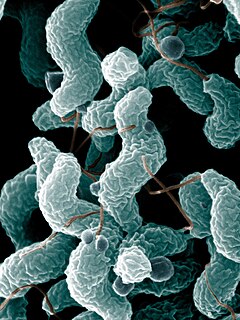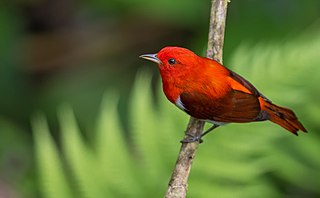
Pseudomonadota is a major phylum of Gram-negative bacteria. The renaming of phyla in 2021 remains controversial among microbiologists, many of whom continue to use the earlier names of long standing in the literature. The phylum Proteobacteria includes a wide variety of pathogenic genera, such as Escherichia, Salmonella, Vibrio, Yersinia, Legionella, and many others. Others are free-living (nonparasitic) and include many of the bacteria responsible for nitrogen fixation.

The Campylobacterales are an order of Campylobacterota which make up the epsilon subdivision, together with the small family Nautiliaceae. They are Gram-negative. Most of the species are microaerophilic.
The Rhodocyclaceae are a family of gram-negative bacteria. They are given their own order in the beta subgroup of Pseudomonadota, and include many genera previously assigned to the family Pseudomonadaceae.

The Aeromonadales are an order of Pseudomonadota, with 10 genera in two families. The species are anaerobic. The cells are rod-shaped. Some species of this order are motile by a single polar flagellum; others are not motile.

The Alteromonadales are an order of Pseudomonadota. Although they have been treated as a single family, the Alteromonadaceae, they were divided into eight by Ivanova et al. in 2004. The cells are straight or curved rods. They are motile by the use of a single flagellum. Most of the species are marine.

The Moraxellaceae are a family of Gammaproteobacteria, including a few pathogenic species. Others are harmless commensals of mammals and humans or occur in water or soil. The species are mesophilic or psychrotrophic (Psychrobacter).
The Alteromonadaceae are a family of Pseudomonadota. They are now one of several families in the order Alteromonadales, including Alteromonas and its closest relatives. Species of this family are mostly rod-like shaped and motile by using one polar flagellum.

The Aeromonadaceae are Gram-negative bacteria. The species are facultative anaerobic organisms. The cells are rod-shaped. They are mostly found in estuarine waters and fresh water, also in soil and sewage. Some are pathogenic for humans and other animals such as fishes and frogs.

Siphonostomatoida is an order of copepods, containing around 75% of all the copepods that parasitise fishes. Their success has been linked to their possession of siphon-like mandibles and of a "frontal filament" to aid attachment to their hosts. Most are marine, but a few live in fresh water. There are 39 recognised families:

Sea lice are copepods of the family Caligidae within the order Siphonostomatoida. They are marine ectoparasites that feed on the mucus, epidermal tissue, and blood of host fish. The roughly 559 species in 37 genera include around 162 Lepeophtheirus and 268 Caligus species.

Betaproteobacteria are a class of Gram-negative bacteria, and one of the eight classes of the phylum Pseudomonadota.

Hexamita is a genus of parasitic diplomonads. It is related to Giardia. H. columbae and H. meleagridis live in the intestines of birds. H. muris and H. pitheci live in the intestines of mammals. H. salmonis and H. truttae live in the intestines of fish.
The Oceanimonas are a genus of marine bacteria. They are, like all Proteobacteria, gram-negative. The rod-shaped, motile organisms are aerobic and chemoorganotroph.
Thauera is a genus of Gram-negative bacteria in the family Zoogloeaceae of the order Rhodocyclales of the Betaproteobacteria. The genus is named for the German microbiologist Rudolf Thauer. Most species of this genus are motile by flagella and are mostly rod-shaped. The species occur in wet soil and polluted freshwater.

The scarlet-and-white tanager is a species of bird in the family Thraupidae. It is found in Colombia and northern Ecuador. Its natural habitats are subtropical or tropical moist lowland forests and heavily degraded former forest. The male is highly distinctive and has bright scarlet upperparts, darker red wings and undertail coverts, and white underparts with a scarlet median stripe running down the throat and belly. Females are patterned like the males, but are olive-brown instead of scarlet.

The salmon louse is a species of copepod in the genus Lepeophtheirus. It is a sea louse, a parasite living mostly on salmon, particularly on Pacific and Atlantic salmon and sea trout, but is also sometimes found on the three-spined stickleback. It feeds on the mucus, skin and blood of the fish. Once detached, they can be blown by wind across the surface of the sea, like plankton. When they encounter a suitable marine fish host, they adhere themselves to the skin, fins, or gills of the fish, and feed on the mucus or skin. Sea lice only affect fish and are not harmful to humans.

This article is about diseases and parasites in salmon, trout and other salmon-like fishes of the family Salmonidae.
Piscirickettsia salmonis is the bacterial causative agent of an epizootic disease in salmonid fishes, piscirickettsiosis. It has a major impact on salmon populations, with a mortality rate of up to 90% in some species. The type strain, LF-89, is from Chile, but multiple strains exist, and some are more virulent than others. P. salmonis and piscrickettsiosis are present in various geographic regions from Europe to Oceania to South America, but the Chilean salmon farming industry has been particularly hard-hit. Different strategies of controlling the disease and farm-to-farm spread have been the subject of much research, but a significant amount is still unknown.
Hahella is a Gram-negative, facultatively anaerobic genus of bacteria from the family of Hahellaceae.
Ackermannviridae is a family of viruses in the order Caudovirales. Gammaproteobacteria in the phylum Proteobacteria serve as natural hosts. There are 2 subfamilies, 10 genera, and 63 species in the family.











